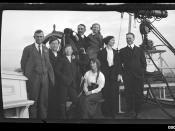At first glance, it would appear that Henry James' "The Turn of the Screw" and Tim Burton's "Edward Scissorhands" have only one thing in common: they are both from the gothic genre. But upon looking closer, one will notice that there are a number of other similar traits between the two. There are noticeable similarities between Edward and the Governess, as well as similarities between Edward and the two children in The Turn of the Screw, Miles and Flora. There are also general themes which the two share - images of a "perfect" society, as well as onlookers who have no control over the situation.
Both "The Turn of the Screw" and "Edward Scissorhands" have many traditional features of the gothic genre. However, when compared to each other, it is found that "The Turn of the Screw" has more of the 'traditional' gothic elements.
These include things such as the mysterious setting; an atmosphere of mystery and suspense that is present throughout the entire novel; visions, which are a regular occurrence for the Governess; supernatural events - such as the 'ghosts' and the 'possessions' of the children; high emotion; women threatened by males, which is found on the many occasions in which the Governess feels threatened by Quint; and there are many instances in which the women of the novel are in distress. In spite of this, a number of these elements can also be found in Edward Scissorhands, if not to a lesser extent. These include elements such as the setting - while the entire movie does not take place in a 'gothic setting', there are times where the viewer is able to see Edward's original home - a mysterious, gloomy castle; an atmosphere of mystery and...

![Mrs. Edwards & Frl. Kussin [boxing] (LOC)](https://s.writework.com/uploads/3/32066/mrs-edwards-frl-kussin-boxing-loc-thumb.jpg)
![[Edward McCall presents a silver basket of flowers to New York Giants manager John McGraw at Polo Grounds, NY (baseball)] (LOC)](https://s.writework.com/uploads/3/32066/edward-mccall-presents-silver-basket-flowers-new-york-giant-thumb.jpg)